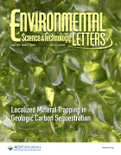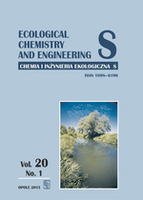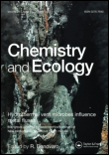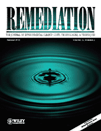
Environmental Chemistry Letters
Scope & Guideline
Empowering the next generation of environmental scientists.
Introduction
Aims and Scopes
- Pollution Remediation Strategies:
Research on various methods and technologies for the detection, removal, and remediation of pollutants from air, water, and soil, including advanced oxidation processes, bioremediation, and nanotechnology. - Sustainable Practices and Materials:
Studies focusing on the development and application of sustainable materials and processes, including biofuels, biodegradable plastics, and green chemistry methodologies that minimize environmental impact. - Chemical Impact on Ecosystems:
Investigations into how various chemicals, including pharmaceuticals and heavy metals, affect aquatic and terrestrial ecosystems, with a focus on toxicity, bioaccumulation, and ecological risk assessment. - Innovative Analytical Techniques:
Development and application of novel analytical methods for detecting and quantifying environmental contaminants, including advanced spectroscopy, chromatography, and sensor technologies. - Climate Change Mitigation:
Research addressing climate change through carbon capture technologies, sustainable energy production, and strategies for reducing greenhouse gas emissions.
Trending and Emerging
- Microplastics and Nanoplastics Research:
A significant increase in studies examining the occurrence, behavior, and effects of microplastics and nanoplastics in various ecosystems, reflecting growing concerns about their environmental and health impacts. - Sustainable Energy Production:
Emerging themes around the production of biofuels, hydrogen generation, and carbon-neutral energy solutions are trending, driven by the global need for sustainable energy alternatives. - Artificial Intelligence and Machine Learning Applications:
The integration of AI and machine learning in environmental chemistry research is gaining momentum, particularly for optimizing treatment processes and predicting environmental outcomes. - Biotechnology in Environmental Remediation:
An upsurge in research utilizing biotechnological approaches, including microbial and enzymatic methods, for the remediation of pollutants and recovery of valuable resources from waste. - Climate Resilience and Adaptation Strategies:
A growing focus on research that addresses climate resilience, including the development of materials and strategies to mitigate the effects of climate change on ecosystems and communities.
Declining or Waning
- Traditional Waste Management Practices:
There is a noticeable decline in publications focusing on conventional waste management techniques, as the journal shifts towards more innovative and sustainable approaches for waste treatment and resource recovery. - Single-Use Plastics and Their Direct Impact:
Research specifically addressing the direct impacts of single-use plastics has decreased, likely due to a broader focus on microplastics and nanoplastics, which encompass a wider range of environmental implications. - Heavy Metal Pollution in Isolated Studies:
While heavy metal pollution remains a concern, studies that focus solely on isolated incidents or specific locations are becoming less common, with a trend towards integrated studies that consider multiple pollutants and their interactions.
Similar Journals

Journal of Hazardous Materials Letters
Elevating awareness and understanding of hazardous materials.Journal of Hazardous Materials Letters, published by ELSEVIER, is a premier open access journal that has rapidly gained prominence in the fields of Environmental Chemistry, Environmental Engineering, Health, Toxicology and Mutagenesis, Pollution, and Waste Management and Disposal since its inception in 2020. With an impressive categorization in the top quartile (Q1) across all its relevant disciplines in 2023, this journal ranks favorably within the Scopus database, positioning itself in the upper echelons of Environmental Science—ranked 23rd in Environmental Engineering and 19th in Health, Toxicology and Mutagenesis among its peers. It serves as a vital platform for the dissemination of high-quality research focused on addressing hazardous materials and their impacts on health and the environment. The journal's commitment to open access facilitates immediate and broad dissemination of research findings, ensuring that essential knowledge reaches a global audience of researchers, professionals, and students eager to advance the field. With its ongoing convergence into 2024, the Journal of Hazardous Materials Letters continues to drive innovation and influence practice in managing hazardous materials for a sustainable future.

INDIAN JOURNAL OF CHEMICAL TECHNOLOGY
Fostering Global Dialogue in Chemical EngineeringThe Indian Journal of Chemical Technology, published by the Natl Inst Science Communication-NISCAIR, is a pivotal platform for the dissemination of innovative research in the field of chemical technology. With an ISSN of 0971-457X and an E-ISSN of 0975-0991, this journal has been serving the academic community since its inception in 1994, and is set to continue through 2024. The journal holds a Q4 ranking in both the Chemical Engineering and Chemistry categories as of 2023, though it showcases a significant breadth of research, making it a valuable resource for both emerging and established scholars. Although it currently operates without an open-access model, the journal aims to facilitate knowledge exchange through rigorous peer-reviewed publications, allowing researchers and professionals to stay updated with the latest advancements and practices in chemical technology. Located in New Delhi, India, the journal not only contributes to national scientific dialogue but also plays a key role in the global conversation around chemical sciences by addressing unique challenges and innovations pertinent to the region.

Environmental Science & Technology Letters
Leading the charge in ecological innovation and sustainability.Environmental Science & Technology Letters, published by the American Chemical Society, stands as a premier journal in the realm of environmental science and technology, focusing on pivotal studies that address pressing environmental challenges. With an impressive Q1 ranking in multiple categories including Ecology, Environmental Chemistry, and Pollution, this journal maintains a position of excellence within its field, achieving Scopus ranks that place it in the top percentile of Environmental Science disciplines. Although not open access, Environmental Science & Technology Letters offers vital insights and cutting-edge research that contribute significantly to the understanding and management of environmental issues. The journal’s objectives include disseminating ground-breaking findings and promoting discussions that lead to sustainable solutions. With convergence from 2013 to 2024, it continues to serve as an essential resource for researchers, professionals, and students committed to advancing knowledge and innovation in environmental science.

Ecological Chemistry and Engineering S-Chemia I Inzynieria Ekologiczna S
Pioneering Sustainable Practices through Ecological ChemistryEcological Chemistry and Engineering S, a prominent journal in the field of Environmental Chemistry and Engineering, provides a platform for innovative research and critical discussions surrounding ecological solutions and sustainable practices. Published by SCIENDO, this peer-reviewed journal is accessible to researchers and professionals dedicated to advancing our understanding of ecological systems and sustainable engineering practices. With an ISSN of 1898-6196 and an E-ISSN of 2084-4549, the journal has established itself in the academic community, reflected by its Q3 ranking in both Environmental Chemistry and Environmental Engineering categories as of 2023. Covering significant advancements from 2008 to 2024, it serves as an essential resource in advancing knowledge and fostering collaborations within interdisciplinary fields. Despite not offering open access, the journal remains an invaluable resource for researchers and students aiming to contribute to ecological sustainability strategies worldwide.

CHEMISTRY AND ECOLOGY
Connecting Chemical Processes to Ecological DynamicsCHEMISTRY AND ECOLOGY is a prestigious academic journal published by TAYLOR & FRANCIS LTD, dedicated to advancing the interdisciplinary understanding of chemical processes in ecological systems. With an ISSN of 0275-7540 and an E-ISSN of 1029-0370, this journal has been a significant contributor to the fields of Earth and Planetary Sciences, Ecology, and Environmental Science since its inception in 1982. The journal is proudly ranked in the second quartile (Q2) in multiple categories, including Earth and Planetary Sciences and Ecology, reflecting its high impact within these disciplines. Despite not being an open-access publication, it provides valuable insights through rigorous peer-reviewed articles that explore the intricate relationships between chemical phenomena and ecological dynamics. Researchers, professionals, and students can rely on CHEMISTRY AND ECOLOGY for the latest findings and methodologies that drive innovation and understanding in environmental chemistry and ecology, enhancing their work and education in this critical area of study.

International Journal of Environmental Research
Exploring the frontiers of environmental science.Welcome to the International Journal of Environmental Research, a premier publication in the field of environmental science, published by Springer International Publishing AG. With an ISSN of 1735-6865 and an E-ISSN of 2008-2304, this journal has established itself as a vital resource for researchers, professionals, and students committed to advancing the understanding of environmental issues. Since its inception in 2007, the journal has maintained an impressive Q2 ranking in Environmental Science (Miscellaneous) and holds a notable 70th percentile position in the Scopus rankings, reflecting its high-quality contributions and reputation in the academic community. While the journal is not Open Access, it provides a platform for rigorous, peer-reviewed research covering diverse topics in environmental science, thus fostering a collaborative and informed approach to addressing global environmental challenges. Located in Switzerland at Gewerbestrasse 11, Cham CH-6330, the journal is committed to publishing innovative research that informs policy and practice, making it an essential reference point for anyone engaged in the study and management of the environment.

Remediation-The Journal of Environmental Cleanup Costs Technologies & Techniques
Exploring Technologies that Shape a Greener FutureRemediation: The Journal of Environmental Cleanup Costs Technologies & Techniques is a pivotal publication in the field of environmental engineering, pollution management, and waste disposal. Published by Wiley since 1990, this journal has established itself as a significant resource for researchers and practitioners dedicated to environmental remediation technologies and cost-effective cleanup techniques. With an impressive scope that spans over three decades and continues to evolve until 2024, the journal is recognized for its valuable contributions, reflected in its Q2 ranking in key categories such as Environmental Engineering, Pollution, and Waste Management and Disposal. Although not currently open access, it offers critical insights and scholarly articles that adhere to rigorous peer-review standards, making it a leading forum for sharing innovative research and practical applications aimed at addressing environmental cleanup challenges. Positioned within the competitive landscape of Scopus rankings, it attracts attention from a global audience, ensuring that its findings resonate within academic, governmental, and industrial domains. Researchers, professionals, and students alike will find Remediation an indispensable tool for advancing knowledge and fostering collaboration in environmental sustainability.

Environmental Chemistry and Ecotoxicology
Transforming environmental science through open access.Environmental Chemistry and Ecotoxicology, published by KEAI PUBLISHING LTD, is a pioneering Open Access journal that has been at the forefront of research since its establishment in 2019. With an impressive trajectory that converges research excellence until 2024, the journal focuses on critical developments in the fields of environmental chemistry and ecotoxicology. It boasts a commendable market position, ranking in the top 3% among leading journals in Agricultural and Biological Sciences, Environmental Science, and related disciplines, as demonstrated by its high Scopus ranks. The journal is committed to disseminating groundbreaking research that addresses the pressing challenges of environmental sustainability and chemical safety, making it an essential resource for researchers, professionals, and students aiming to navigate the complexities of our ecological landscapes. By embracing an Open Access model, the journal ensures that valuable insights are accessible to a global audience, fostering collaboration and innovation in the field.

ENVIRONMENTAL POLLUTION
Exploring solutions for a cleaner, healthier planet.Environmental Pollution, published by Elsevier Science Ltd, stands at the forefront of research related to environmental contaminants and their effects on health and ecosystems. With an impressive impact factor reflected in its Q1 rankings across various categories including Health, Toxicology, and Pollution, this journal is a pivotal resource for academics and professionals in the fields of environmental science and toxicology. The journal, established in 1973, continues to disseminate high-quality articles that explore the implications of pollution and advance knowledge on toxicological impacts and mitigation strategies. Although it is not an open-access journal, it offers robust visibility within the scientific community, ensuring vital research reaches those who need it most. Researchers, students, and professionals dedicated to understanding and addressing the challenges of environmental pollution will find Environmental Pollution to be an indispensable platform for their work, guiding the ongoing dialogue on sustainable practices and public health protection.

ENVIRONMENTAL SCIENCE AND POLLUTION RESEARCH
Pioneering Research in Environmental ScienceEnvironmental Science and Pollution Research is a premier international journal published by Springer Heidelberg, dedicated to advancing knowledge in the field of environmental science and pollution. With an impressive impact factor reflecting its vital contributions to research, the journal is categorized in the top quartiles (Q1 and Q2) across several domains, including Health, Toxicology and Mutagenesis, and Environmental Chemistry. Established in 1994, it continues to be a critical resource for researchers, professionals, and students focusing on pressing environmental issues. The journal provides an insightful platform for disseminating significant findings related to pollution and its effects on health and the environment, contributing to a better understanding and resolution of these challenges. While it currently does not offer Open Access options, its inclusion in prominent rankings, such as the Scopus rankings, underscores its reputation and influence within the scientific community.